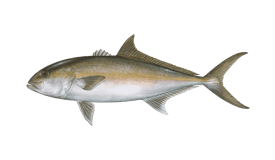Amberjack

Amberjack
Amberjacks are the largest fish of the Carrangidae family (which includes Jacks and Trevallies) and are widely targeted for their hard fighting game qualities. Big and powerful, these fish strike fast, pull hard and do deep and forceful dives to the bottom.
This species mostly inhabits reefs and wrecks from 60 to 240ft deep, but can often be found around floating objects and near the surface. Amberjacks have been caught inshore in Florida as well. Young ones move in schools, but older fish are mostly loners.
How big
Amberjacks have an elongated body that can grow to about 6ft and 160lbs. The average catch will be between 20 and 40lbs though, but, depending on where and when you target them, larger fish can be a commodity. They live around 17 years and mature at 4-5.
When & Where
This species can be found in tropical and warm temperate waters worldwide, including: the Indo-Pacific - around Madagascar, in the Persian Gulf, around south Japan (where the record fish was recently caught), China and the Philippines; around Hawaii; in the western Atlantic from Nova Scotia to Brazil, including the Gulf of Mexico, Bermuda and the Caribbean Sea; in the eastern Atlantic from the British isles to Morocco and in parts of the Mediterranean Sea, but also off southern and western Africa. They're replaced by Yellowtail Amberjack off Australia and California.
The warmer the waters, the more AJs around, with Miami and the Keys being perfectly positioned to be a year-round fishery in the USA. Fishing farther up north along the Atlantic coast and the Gulf coast will be the most productive early spring through the end of May.
How to catch
Amberjacks are opportunistic feeders that will go for most any type of bait (live, dead, strip, plugs, jigs, spoons, flies) as long as it's presented well.
If located around deep reefs, dropping down some speedo mackerel (or other bigger live baitfish) in approach from the down current side will work great, as will deep vertical jigging coming from the upcurrent side - change the depth frequently until a strike occurs.
If you want to get the fish closer to the surface, you should tease them with live bait tied to a line with no hook. When they come up, either fast trolling or using large, noisy, poppers or surface plugs will get you a bite.
Amberjacks usually hook themselves, so setting the hook is mostly not necessary. Once they've got the bait, you should allow the initial run, but as soon as it's over, they will make a dash for the bottom, where the line can easily get cut on the structure. When boated, it's common that other Amberjacks follow up.
Good to eat?
Lean, firm and white meat with mild taste. However, Amberjacks are highly ranked among tropical fish species known to cause ciguatera (fish poisoning). Bigger fish should be released as a precaution.
Regulations
Season - Gulf waters - closed June 1 - July 31; Atlantic waters - open year-round;
Size limit (minimum) - Gulf state waters - 34'' FL, except 30''FL for Mississippi; Atlantic state waters - 28'' FL, except 32'' for Virginia;
Bag limit (per angler per day) - 2 for Virginia, 1 for all other states;